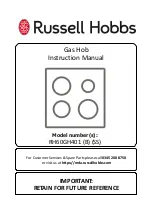
4
to the hotplate. The hose should not be subjected to abrasion, kinking or permanent deformation and should be able to be inspected
along its entire length. Unions compatible with the hose fittings must be used and connections tested for gas leaks.
The supply connection point must be accessible with the appliance installed. Fit the supplied elbow and gasket as shown in Fig.16 The
gas inlet connection has a 1/2" BSP male thread. When making the connection, take care not to apply excessive stress by
counterbalancing tightening force. Ensure that the available gas supply is the same as the gas type label affixed to the base of the hob.
If not, contact Bertazzoni for a Gas Conversion Kit. The gas supply pressure must be adjusted in accordance with the data label for the
gas type.
Natural Gas
The natural gas regulator supplied must be fitted for natural gas. Ensure the arrow on the regulator points towards the direction of the
gas flow. The test point pressure must be adjusted to 1.00 kPa with the largest burner operating on maximum flame.
U-LPG
Fit the Universal LPG test point assembly (supplied in the gas conversion kit). An AGA Approved gas regulator suitable for a supply
pressure of 2.75kPa should be part of the gas tank supply.
ADAPTING TO DIFFERENT TYPES OF GAS
Before carrying out any maintenance work, disconnect the appliance from the gas and electric supply.
- CHANGING THE NOZZLES FOR USE WITH OTHER TYPES OF GAS:
To change the nozzles of the burners use the following procedure:
Lift up the burners and unscrew the nozzles ( Fig. 7) using an adjustable spanner of 7 mm and change the nozzles with those designed
for the new gas supply according to the information given in TABLE N° 2 shown below.
ATTENTION: After carrying out the changes described above, the technician must put the label corresponding to the new gas
supply on the appliance to take the place of the old label. This label is found in the bag containing spare nozzles.
TABLE N°2: Adaption to various types of gas
Burner
Types of Gas
Pressure
Nozzle Diameter
Hourly Gas Consumption
kPa
mm.
(MJ)
Auxiliary NG 1.0
0,92
4.2
U-LPG
2.75
0,56
4.0
Semi-Rapid NG
1.0 1,17
6,6
U-LPG
2.75
0,73
6,9
Rapid NG
1.0
1,55 11.5
U-LPG
2.75
0,98
12.3
Wok (Inner ring)
NG
1.0
0.80
3.1
U-LPG
2.75
0.50
3.1
Wok
(Inner + Outer ring)
NG 1.0
0.80
(Inner)
1.14 x 2 (Outer)
15.6 (combined)
U-LPG
2.75
0.50
(Inner)
0.70 x 2 (Outer)
15.6 (combined)
REGULATION OF BURNERS:
1) Regulation of the "MINIMUM" on the burners
To regulate the minimum on the burners carry out the following procedure indicated below:
1) Turn on the burner and put the knob onto position MINIMUM ( small flame ).
2) Remove the knob ( Fig. 8) of the tap which is set for standard pressure. The knob is found on the bar of the tap itself.
3) Beside the tap bar on the work top, use a small screwdriver that fits the screw (gold) found on the lower part of the tap (auxiliary,
semirapid, rapid Fig. 8) (dual fig.9) and turn the fixing screw to the right or left until the flame of the burner is regulated in the most
suitable way to MINIMUM.
4) Make sure that that the flame does not go out when changing the position quickly from MAXIMUM to the MINIMUM position.
ATTENTION: The regulation described above can be carried out only with burners using methane gas and city gas ( where
available), while with burners using liquid gas the screw must be fully screwed in, in a clockwise direction.
CONNECTION OF THE APPLIANCE TO THE ELECTRICITY SUPPLY:
Connection to the electricity supply must be carried out according to the norms and indications of the law in force.
Before carrying out the connection check that:
- The electric charge of the system and the sockets are suitable for the maximum power of the appliance (see label on the lower part of
the case).
- The socket or system is equipped with an efficient earth connection according to the norms and indications of the law currently in force.
No responsibility can be held if these indications are not respected.
When the connection to the electricity supply is made with a socket.
Fit onto the electric cable a standard plug ( if it is not provided ) which is appropriate for the charge indicated on the label. Connect up
the wires according to the diagram in Fig. 10 taking care to respect the corresponding pairs listed below:
letter L (phase) = brown coloured wire;
letter N (neutral) = blue coloured wire;
symbol”
”
earth = green-yellow coloured wire;
-
The electric cable must be positioned so that it cannot reach a temperature of over 75 K at any point.
- Do not use reducers, adapters or shunts for the connection as they could cause false contacts and subsequent dangerous
overheating.
WARNING:
The plug must be made accessible after installation for easy servicing and maintenance.






























